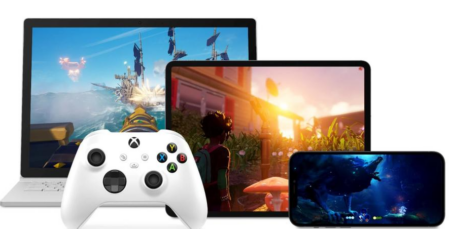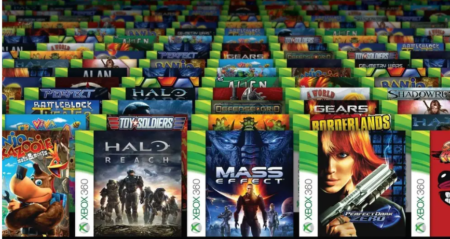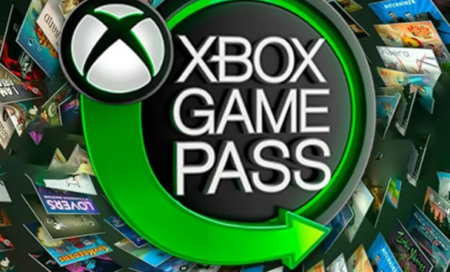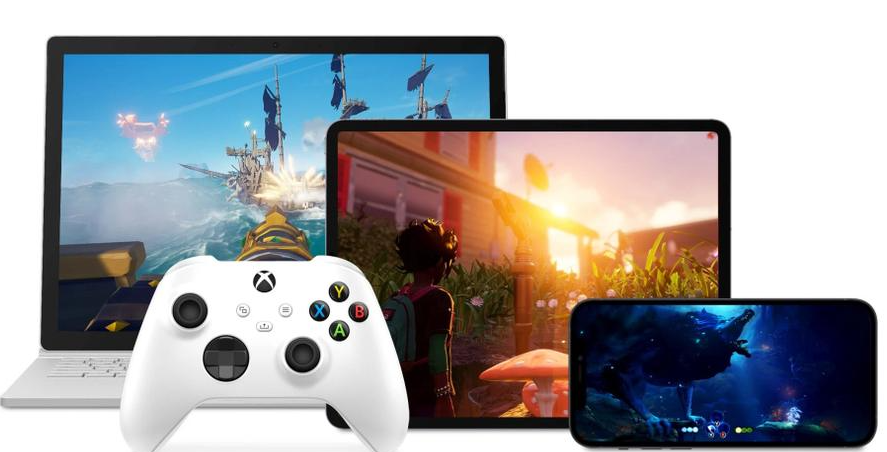It was smooth on paper, but they forgot about the ravines – the expression perfectly describes the situation in which the Xbox Game Pass service found itself. Plans to capture the global gaming market by Microsoft when confronted with reality showed their inconsistency. And although the service has proven to be viable, unlike Google Stadia, its future is questionable.
Spencer’s dead end. Dreams and reality Game Pass

Game Pass in the rainbow world of pink ponies
Microsoft launched the Game Pass service in 2017. In the year of launch, it was available to owners of Xbox consoles, and the library included more than 100 games for the One X|S and 360 models, including popular projects from the company itself: Minecraft, the Gears series and Halo. Subscription prices started at $10 per month. A little later, the service was extended to PCs and smartphones, combining Game Pass with the Xbox Cloud Gaming cloud service.
By the time Game Pass launched, subscription services were already widespread, but not on the scale that Microsoft offered. The business strategy developed under the leadership of Phil Spencer is similar to that used by Netflix. The company, which initially sold DVDs of films and then provided them via subscription, was one of the first to catch the trend .
Content producers were initially skeptical of the idea, so Netflix had to create the content itself. The success was stunning. Nowadays online cinemas no longer cause a stir, but in the late 00s everyone was talking about Netflix.
Microsoft, in theory, had every opportunity to repeat this path of success in the gaming market. Moreover, the initial conditions were even better than those of Netflix at one time. Microsoft had the Xbox platform, the second most popular in the major gaming markets, was a major game publisher and did not need money.
The new business strategy, the development of which began in 2013, suggested such rosy prospects that reading the interviews given by the head of the Xbox gaming division Phil Spencer was breathtaking. Microsoft promised to reinvent the gaming market.
Resistance from third-party publishers has been great , according to Sarah Bond, head of gaming ecosystems at Microsoft . Studio executives believed that Game Pass would devalue games. But Xbox thought differently, and since the simultaneous release of Sea of Thieves on Xbox Game Pass and in retail, all games from Microsoft’s internal studios have been released on the subscription service.
Another important decision was backward compatibility. Microsoft has decided to abandon console generations. The idea belonged to Karim Choudhry, who headed the cloud gaming direction at Xbox. This made it possible to include popular hits from the Xbox 360 and even the first Xbox into the library at the very start. According to Choudhry, backward compatibility has become an important part of the strategy.

But the key decision was different. Competition in the console market with Sony PlayStation is too small for such a large corporation. The synergy of the Game Pass service, backward compatibility and cloud gaming, in the view of the corporation’s management, should have given the opportunity to touch games to 2 billion players around the world on any device. “We know that we won’t be able to sell 2 billion consoles, there are many markets around the world where the console is not part of the lifestyle,” said Karim Choudhry .
Phil Spencer outlined even more ambitious goals in 2020 : “I don’t want to get involved in format wars while Amazon and Google are focused on how to bring games to 7 billion people around the world. Ultimately, this is our goal.”
The company did not rule out cooperation with competitors. “We want to bring Game Pass to any device that anyone wants to play on,” Spencer said. “Not just because it’s our business, but because the business model allows people to consume and find games that they wouldn’t play anywhere else.”
In addition, according to Spencer, the actual sale of consoles is not a business that allows you to make money. The gaming business, according to the head of Xbox, is the sale of games and the sale of access to them and content.
Under this strategy of Phil Spencer, Microsoft has invested billions of dollars in the gaming direction – the purchase of Minecraft for 2.5 billion, the purchase of Zenimax and a subsidiary of Bethesda for 7.5 billion, the planned acquisition of Activizion Blizzard for 70 billion. And that’s not counting smaller acquisitions. If you don’t take into account the yet-to-be-closed deal to acquire Activizion Blizzard. Phil Spencer increased the number of internal Xbox studios from five to twenty-
In fact, the entire business model of the Xbox gaming division was reformatted. Now Xbox is not a console, not a hardware platform for running games. From now on, Xbox is a Game Pass subscription service that includes backward compatibility with older games, cloud gaming and hardware platform independence. In the company’s vision, gamers should be able to buy Game Pass on Xbox, PC, smartphones running iOS and Android, and in general on any device that can run games or a cloud gaming client.
The ideal Game Pass is two billion players following a single Path of Games in the clouds, where a rainbow of inclusivity, tolerance and world peace is visible. And all these two billion players are fed by the modest good corporation Microsoft on a pink pony for $10 a month.
Harsh reality
At first glance, Phil Spencer’s business strategy is working, although for some reason Microsoft is in no hurry to share financial figures. The gaming community learns about the successes of the service through rumors, and through leaks from the company itself and from government agencies checking the deal to purchase Activizion Blizzard.
However, the company shared one figure. As of the beginning of 2022, the number of service users was 25 million people . Is it a lot or a little? The number of Xbox One consoles sold exceeds 40 million units. As of April 2022, almost 14 million Xbox Series consoles have been sold .
Thanks to leaks from the Brazilian regulator checking the acquisition of Activizion Blizzard, it became known how much money the company makes from the service. For 2021, revenue was $2.9 billion, but expenses were not disclosed. This compares well with the previously published figure for the number of users of the service – if $2.9 billion is divided by $120 per year per user, we get 24.2 million users.
There is no exact information about what part of the income comes from consoles and what part from PCs and smartphones. However, given the geography of Xbox sales, which mainly covers the US, European countries and the UK, it can be assumed that the majority of subscriptions are for the console, since the PC is less popular in the gaming market in these countries.
Moreover, Game Pass seems to be a “system seller” of Xbox consoles. There are no significant gaming projects in the Microsoft portfolio comparable in quality to Play Station exclusives. But Game Pass offers old, proven hits from both the company itself and Bethesda, Electronic Arts, and new indie games at a reasonable price.
Overall, Game Pass looks like a good deal on consoles. Compared to gaming PCs, Xbox Series consoles are cheap, convenient, and the low-cost subscription service complements popular free-to-play gaming services.
However, outside of the premium markets of Europe and the US, the situation for Game Pass is not so rosy. The third-largest premium gaming market in Japan remains unconquered for Microsoft. Over the 20 years of Xbox’s existence, only 2.3 million units were sold there . The most successful model turned out to be the Xbox 360. Sales of the rest amount to hundreds of thousands. Rumors about the appearance of the service on Nintendo Switch, which appeared in 2021, have so far remained rumors.
In the market of Russia and many other developing countries, the PC dominates the gaming sector. Considering the peculiar attitude towards unlicensed content in such countries, as well as adequate pricing for PC games on Steam, buying Game Pass no longer looks so attractive.
Microsoft would obviously really like to expand its audience to include PlayStation owners. As already mentioned, company executives have repeatedly hinted at this. Moreover, according to available information, Microsoft made a corresponding offer to a competitor.
However, Sony decided to fight to the end. The company cannot afford a similar service for financial reasons. According to Sony boss Jim Ryan, the Game Pass business model won’t work. However, Microsoft had to respond to the actions. Not being able to create a Game Pass, I had to make my own from what I had.
But this is not the only battlefield between the two competitors. Sony seems to have managed to convince the British regulator assessing the deal to buy Activizion Blizzard that Microsoft is not as herbivore as it wants to seem. The press received information about the skepticism of British officials about the deal. Such publications caused deep irritation in the Microsoft camp.
However, there is a possibility that the deal to purchase Activizion Blizzard did not really imply the exclusivity of Call of Duty for PC and consoles. Perhaps Microsoft’s goal was to persuade Sony to allow the Game Pass service on its platform. The most popular franchise in the Western gaming market, Call of Duty, will not be exclusive to the Xbox platform, because it will be available on PlayStation with a Game Pass subscription! And only if Sony once again rejects the offer, PlayStation will lose Call of Duty due to Microsoft’s comments that they, they say, offered a good option and did everything they could for Sony in the current situation.
Such a scenario cannot be ruled out. However, Sony covered its rear for several years. From British sources on the Internet, information leaked that Sony blocked the release of new games in the Call of Duty franchise on Game Pass for several years, due to how much the company is allergic to this service.
But even if Game Pass does appear on PlayStation, and Phil Spencer agrees with Valve that the service will appear on Steam and can be appreciated by PC players around the world (with the exception of China), then the audience target is 2 billion people will still not be achieved.
With over 100 million PS4s sold, tens of millions of PS5s and hundreds of millions of gaming PCs are still outnumbered by mobile devices. Smartphones running iOS and Android could indeed provide a billion-dollar audience for the service, but despite the efforts made in this direction, Game Pass has not yet gained popularity on mobile phones. What is the reason?
There are several reasons. Modern smartphones are already comparable in performance to consoles of the past and the generation before last. Some companies have successfully ported older games to mobile platforms and tried to sell them there, with varying degrees of success. However, not a single publishing house reported on truly significant sales.
The audience of mobile players has its own specifics. Accustomed to high-quality, beautiful and exciting shareware mobile game services, gamers are not ready to buy old games that look worse on smartphones than existing new ones, and often also have problems with quality and management. Porting is done by small studios “for three kopecks”. There is neither time nor money to make significant changes, and the number of buttons that are located on the gamepad simply does not fit on the smartphone screen. Not everyone will agree to carry a separate gamepad with them for “mobile gaming”.
Modern “adult” games and the hardware platform of smartphones are not yet capable of handling them. Even if it’s a smartphone from Apple, not to mention Chinese Android devices. The problem can be solved with the help of cloud gaming and Microsoft provides users with such a service. The company proudly states that cloud-based Game Pass has been “ tried ” by 10 million people since launch. However, how many of these 10 million remained active after the trial period, Microsoft CEO Satya Nadella did not specify.
In addition to purely technical obstacles in the development of cloud gaming, other difficulties have arisen. Mobile giants have their own gaming services and their own vision of the industry. This is how Google developed the Play Pass services and the defunct Stadia, while Apple developed the Arcade subscription with exclusives. So none of these companies are in a hurry to provide Microsoft with the opportunity to make money from “their” audience.
And if Microsoft did not have any special problems with the formally open Android platform, then something went wrong with iOS. And iPhone smartphones dominate the largest gaming markets in the US, Japan and Europe. Apple said that it cannot allow the service on iOS in the form in which Microsoft offers it. Each game must be sold separately. Xbox has found workarounds , but I can’t call them comfortable.
However, Microsoft believes that cloud gaming will allow the Xbox gaming division to achieve its goals in the future.
Gloomy future
As of today, Game Pass has found itself at a standstill, locked within the Xbox ecosystem. The service feels good on its native platform, and it’s a really good value proposition. However, even within the native platform, the prospects look vague.
Games from independent developers cannot attract the entire audience of players. Microsoft’s huge investments in the gaming division and the purchase of numerous studios have not yet justified themselves. The mountain of money at the moment has only given birth to a mouse in the form of Halo Infinite, Forza Horizon 5 and Gears 5. It’s not about the quality of these products. The fact is that since the start of the service in 2017, these are the only top releases that are conditionally comparable to Sony exclusives. Xbox still can’t break out of the Halo-Giri-Fortz vicious circle.

Backwards compatibility, access to indie games and old hits via subscription work on consoles, but not on PC. Especially in developing countries. PC means free multiplayer for any games, free upgrade on Steam to remastered games for owners of the originals, regional prices and no tax of 10 euros on “next-gen” when purchasing games. All this is on one side of the scale, and on the other are Microsoft services and an inexpensive Xbox console.
Are PC players from developing countries ready to trust an American corporation? This applies not only to PC gaming, but also to cloud gaming.
To work well in the cloud and broadcast images to the device, it is necessary to locate data centers as close to the user as possible, i.e. create or transfer capacity to those countries where it is planned to offer the service.
In the case of the USA and Europe there are no such problems. Microsoft is present in these markets not only through its Xbox gaming division, but also offers its business services to consumers. But in other countries this is not the case.
After recent events, the company officially left Russia, so cloud Game Pass will not be available to our players in the foreseeable future. And after such a demarche, will China, India, and Arab countries be ready to allow Microsoft into their market?
In addition, like other large IT corporations, Microsoft has its own graveyard of closed projects. I wonder if the ashes of Nokia and Windows Phone did not knock on Phil Spencer’s heart when Apple “shaved” the Xbox Game Cloud and did not allow the service on its platform? There are no guarantees that Microsoft will develop Game Pass in the direction it promised without reaching its targets without the smartphone, PC and PlayStation audience.
